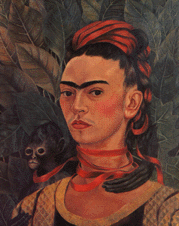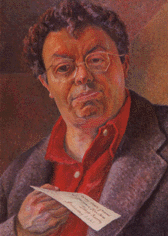
Frida Kahlo, Self-portait with monkey, 1940 Frida Kahlo (1910-1954) and Diego Rivera (1886-1957), two of Mexico's greatest artists, have been reunited for the first time in an exhibition running until June 18th 1998 at the Fondation Gianadda in Martigny, Switzerland.
Jewish-born Frida Kahlo, who suffered most of her life from the after effects of serious injuries after being run down by a tramcar, and Diego Rivera, a pioneer of Mexican modern art truly formed a legendary couple.
She usually painted self-portraits trying to overcome a cruel and painful existence while he mainly worked to express his revolutionary feelings half way between Cubism and Figurative painting. Their works, attractive and troublesome at the same time are in fact quite complementary despite the fact that Frida, much fragile and ill, had a will of iron while Diego, full of energy and strength, appeared much weak in the face of critics and hostility. Frida was deeply mystical and Diego was above all Mexican. She was chiefly concerned with herself while he was mainly interested in describing the plight of his people. Brought together their works in fact give new clues about the way they | 
Diego Rivera, Self-portrait, 1941 expressed their feelings. Finally, there is some kind of complicity between them which had yet to be perceived.
Frida, so defiant in her self-portraits portly unravels her soul with some kind of raging passion. She is like a living statue resisting invisible forces and posing arrogantly though with the look of a Madonna. In that sense she is somewhat inclined to some deep intimacy while Rivera is simply a gifted painter who has been under the influence of European artists and new trends such as Cubism. He nevertheless violently clung to his Mexican roots, opposing tradition against modernity, freedom against oppression, communism against capitalism with quite a certain talent.
Rivera was in fact a revolutionary with the soul of an anarchist and is shown in Martigny solely through his paintings and not his monumental wall frescoes glorifying the Mexican people and which are more explicit of his way of expressing movement and space as well as telling a story.
There is much sensuality, unconstrained violence and technique in his painting whereas Frida Kahlo, showing a moving intimacy in her solitude, is masking her wounded feelings beneath the disturbing image of herself. She is observing and being observed exhilarating her beauty in opposition to Rivera who, swept by his buoyant passion, sometimes seems to go astray in his paintings. |